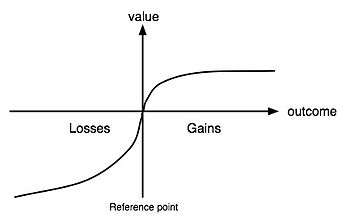Amos Tversky
| Amos Tversky | |
|---|---|
 | |
| Born |
March 16, 1937 Haifa, Mandatory Palestine |
| Died |
June 2, 1996 (aged 59) Stanford, California |
| Nationality | Israeli |
| Fields | Cognitive psychology, Behavioral economics |
| Institutions |
Hebrew University Stanford University |
| Alma mater |
University of Michigan Hebrew University |
| Known for |
Prospect theory Heuristics & biases |
| Notable awards | Grawemeyer Award in Psychology (2003) |
Amos Nathan Tversky (Hebrew: עמוס טברסקי; March 16, 1937 – June 2, 1996) was a cognitive and mathematical psychologist, a student of cognitive science, a collaborator of Daniel Kahneman, and a figure in the discovery of systematic human cognitive bias and handling of risk. Much of his early work concerned the foundations of measurement. He was co-author of a three-volume treatise, Foundations of Measurement (recently reprinted). His early work with Kahneman focused on the psychology of prediction and probability judgment; later they worked together to develop prospect theory, which aims to explain irrational human economic choices and is considered one of the seminal works of behavioral economics. Six years after Tversky's death, Kahneman received the 2002 Nobel Prize in Economics for the work he did in collaboration with Amos Tversky.[1] (The prize is not awarded posthumously.) Kahneman told The New York Times in an interview soon after receiving the honor: "I feel it is a joint prize. We were twinned for more than a decade."[2] Tversky also collaborated with many leading researchers including Thomas Gilovich, Itamar Simonson, Paul Slovic and Richard Thaler. A Review of General Psychology survey, published in 2002, ranked Tversky as the 93rd most cited psychologist of the 20th century, tied with Edwin Boring, John Dewey, and Wilhelm Wundt.[3]
Biography
Tversky was born in Haifa, British Palestine (now Israel). He served with distinction in the Israel Defense Forces, rising to the rank of captain and being decorated for bravery. He received his undergraduate education at Hebrew University of Jerusalem in Israel, and his doctorate from the University of Michigan in Ann Arbor in 1964. He later taught at Hebrew University before moving to Stanford University. In 1980 he became a fellow of the American Academy of Arts and Sciences.[4] In 1984 he was a recipient of the MacArthur Fellowship, and in 1985 he was elected to the National Academy of Sciences.[5] Amos Tversky was married to Barbara Tversky, now a professor in the human development department at Teachers College, Columbia University. Tversky, co-recipient with Daniel Kahneman, earned the 2003 University of Louisville Grawemeyer Award for Psychology.[6] He died of a metastatic melanoma.[7]
Career
Comparative Ignorance
Tversky and Fox (1995)[8] addressed ambiguity aversion, the idea that people do not like ambiguous gambles or choices with ambiguity, with the comparative ignorance framework. Their idea was that people are only ambiguity averse when their attention is specifically brought to the ambiguity by comparing an ambiguous option to an unambiguous option. For instance, people are willing to bet more on choosing a correct colored ball from an urn containing equal proportions of black and red balls than an urn with unknown proportions of balls when evaluating both of these urns at the same time. However, when evaluating them separately, people are willing to bet approximately the same amount on either urn. Thus, when it is possible to compare the ambiguous gamble to an unambiguous gamble people are averse — but not when one is ignorant of this comparison.
Notable contributions

- foundations of measurement
- anchoring and adjustment
- availability heuristic
- base rate fallacy
- conjunction fallacy
- framing
- behavioral finance
- clustering illusion
- loss aversion
- prospect theory
- cumulative prospect theory
- representativeness heuristic
- Tversky index
- support theory
- contrast model
In popular culture
Tversky Intelligence Test
As recounted by Malcolm Gladwell in 2013's David and Goliath: Underdogs, Misfits, and the Art of Battling Giants, Tversky's peers thought so highly of him that they devised a tongue-in-cheek one-part test for measuring intelligence. As related to Gladwell by psychologist Adam Alter, the Tversky Intelligence Test was "The faster you realized Tversky was smarter than you, the smarter you were."[9]
References
- ↑ Altman, Daniel (10 October 2002). "A Nobel That Bridges Economics and Psychology". The New York Times. Retrieved 14 March 2009.
- ↑ Goode, Erica (5 November 2002). "A Conversation with Daniel Kahneman; On Profit, Loss and the Mysteries of the Mind". The New York Times. Retrieved 14 March 2009.
- ↑ Haggbloom, Steven J.; Warnick, Renee; Warnick, Jason E.; Jones, Vinessa K.; Yarbrough, Gary L.; Russell, Tenea M.; Borecky, Chris M.; McGahhey, Reagan; et al. (2002). "The 100 most eminent psychologists of the 20th century". Review of General Psychology. 6 (2): 139–152. doi:10.1037/1089-2680.6.2.139.
- ↑ http://www.amacad.org/publications/BookofMembers/ChapterT.pdf
- ↑ "National Academy of Sciences".
- ↑ "2002- Daniel Kahneman and Amos Tversky". Archived from the original on 2015-07-23.
- ↑ Freeman, Karen (6 June 1996). "Amos Tversky, Expert on Decision Making, Is Dead at 59". The New York Times. Retrieved 14 March 2009.
- ↑ Fox, Craig R.; Amos Tversky (1995). "Ambiguity Aversion and Comparative Ignorance". Quarterly Journal of Economics. 110 (3): 585–603. doi:10.2307/2946693. JSTOR 2946693.
- ↑ Malcolm Gladwell, David and Goliath: Underdogs, Misfits, and the Art of Battling Giants, 2013, page 103
External links
- Memorial Resolution - Amos Tversky
- Boston Globe: The man who wasn't there
- Daniel Kahneman – Autobiography